Is an expansion tank required?
Private, older public, and some other water distribution systems may not require an expansion tank to be installed. This is because these systems may be considered “open”, since they lack pressure regulators and/or backflow preventers. Plumbing code changes intended to prevent the contamination of the public water supplies, have made backflow prevention a requirement in most current new builds. While this may be a good change for the water supply, it can be a damaging change to your plumbing system.
IRC2009 P2902.3 Backflow protection. A means of protection against backflow shall be provided in accordance with Sections P2902.3.1 through P2902.3.6. Backflow prevention applications shall conform to Table P2902.3, except as specifically stated in Sections P2902.4 through P2902.5.5.
Before pressure reducing valves and backflow preventers were used, any excess pressure in your system could easily spread back into the water distribution system. This meant any thermal expansion of the water caused by your domestic hot water (DHW) system, could easily be dissipated back through the distribution system. Now that backflow prevention is required, your plumbing system has become a “closed” system, and a new way must be employed to prevent over pressurization.
This is where expansion tanks come in. Expansion tanks are used to absorb any excess pressure created due to thermal expansion, which prevents an over pressurization of the system. In any situation where water in a “closed system” is heated, an expansion tank is required.
IRC 2009 P2903.4 Thermal expansion control. A means for controlling increased pressure caused by thermal expansion shall be installed where required in accordance with Sections P2903.4.1 and P2903.4.2. P2903.4.1 Pressure-reducing valve. For water service system sizes up to and including 2 inches (51 mm), a device for controlling pressure shall be installed where, because of thermal expansion, the pressure on the downstream side of a pressure-reducing valve exceeds the pressure-reducing valve setting. P2903.4.2 Backflow prevention device or check valve. Where a backflow prevention device, check valve or other device is installed on a water supply system using storage water heating equipment such that thermal expansion causes an increase in pressure, a device for controlling pressure shall be installed.
Symptoms of an over pressurized system
High pressure in a plumbing system can damage any fixture connected to the system, including faucets, taps, toilets, washing machines, dish washers, water heaters, etc. It can also lead to leaks, running toilets, difficult to operate faucets and taps, and even burst pipes. A frequent symptom of an over pressurized system, is a sudden surge of water when a faucet is turned on. The surge will quickly dissipate, and won’t return even if you close and reopen the valve.
If the over pressurization is caused by thermal expansion, you may only notice symptoms occasionally and seemingly randomly. This is because the pressure in the system increases when the water heater is heating, and all fixtures are closed. The pressure diminishes when any fixture is opened, or as the water cools. The problem may only be observed when the system pressure is at its highest, which may only be on rare occasions.
What is an expansion tank?
An expansion tank physically resembles a small propane tank.
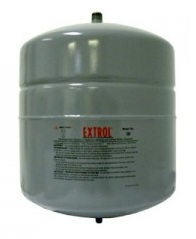
It’s usually installed fairly close to a water heater or boiler, and may be installed in almost any orientation. Internally, there will likely be a flexible (Butyl) diaphragm which divides the tank in two. On the “wet” side, you’ll notice a 3/4” NPTM connection which allows it to be connected to the plumbing system. The “dry” side, often features a Schrader valve which allows the pressure of the tank to be adjusted as needed.
Normally the tank will be completely filled with air, and the diaphragm will be pressing against the water inlet. As the water pressure increases, it compresses the lower pressure air in the tank, and the tank fills with water. When the system water pressure decreases, the air pressure forces the water out of the tank, and back into the pipes.
How do I install an expansion tank?
Expansion tanks are installed on the cold water supply of a domestic hot water tank, or boiler. The installation process is fairly easy, usually only requiring a tee fitting to be added to the water line.
Positioning
The first step in installing an expansion tank, is to decide where you want it. We already know that the tank must be installed between the cold water shut off, and the water heater inlet. So we know where it has to connect to the system, but we still have to decide where the tank itself will sit.
Up, Down, Left, or Right?
Most tanks can be installed in any orientation, though there are advantages to some positions. For example. If you install the tank vertically with the air side up, and the tanks bladder ever fails. The tank may continue to function (though at a reduced capacity), until the air escapes from the tank. Whereas, if the tank was installed with the air side down, and the bladder failed. The air would immediately move to the top of the tank, and the tank would fill completely with water.
Support
While most smaller tanks can be supported by the plumbing itself, it can be a good idea to support the tank by other means. Water weighs about 8.34 lbs/gallon, which means even a properly functioning tank can weigh quite a bit. Lets look at an example tank.
- Tank Capacity: 4.4 gallons.
- Maximum Accept Capacity: 2.5 gallons
- Tank Weight: 8 lbs
Maximum Properly Functioning Weight:
2.5 gallons * 8.35 lbs/gal. + 8 lbs = 28.875 lbs.
Maximum Failure Weight:
4.4 gallons * 8.35 lbs/gal. + 8 lbs = 44.74 lbs.
Even when the tank is in working order and fills to maximum capacity, you could end up with almost 29 lbs hanging from your pipes. Because of this, it may be a good idea to attach the tank to a nearby structural member. This can be easily accomplished, using straps and/or brackets designed for this purpose.
Installation
Now that we’ve decided where the tank will connect to the plumbing, and where the tank will spend the rest of its life. It’s time to start the actual installation.
Turn off the water
The first thing you’ll have to do is to figure out how to turn off the water heater/boiler, and then actually turn it off. Next you’ll have to locate the cold water supply shutoff valve, and turn the valve to the closed (off) position. Finally, turn on (open) the lowest hot water tap in the house. This will release any built up pressure, and prevent water from spraying out when you cut the pipe in the next step.
Mark and cut the pipe
Use the tee as a guide, and mark the pipe where you’ll be installing the tee. Cut the pipe at your marks, using a pipe cutter.
If you don’t have to cut the pipe, skip this step.
Install the tee
Solder, snap, or twist the tee into place. Then install any nipples or extension pipes required to reach the tanks final resting place. You’ll want to end the extension with a 3/4” NPTF fitting, so the expansion tank can be screwed into place.
At this point you may want to think about adding some extra fittings that will make required maintenance easier. A ball valve and spigot, will make isolating and draining the tank much more convenient. Installing a combination fitting like this Ball drain valve, can make this task much easier and clean looking (Make sure to check your local codes to insure this type of setup is allowed.).
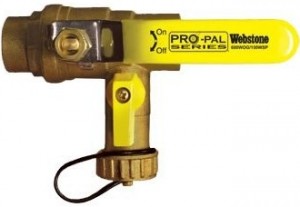
Check the system pressure
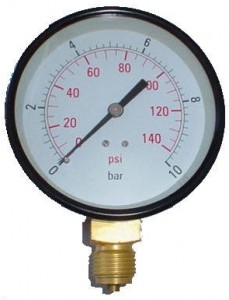 At this point you’ll want to close the faucet you opened, and open the shutoff valves (make sure you cap the extension pipe, or close the valve on the extension, or you’ll have water everywhere). Turn on all the hot water fixtures in the house until water flows normally (no sputtering), to insure the system is filled and at full pressure. Check for, and repair leaks.
At this point you’ll want to close the faucet you opened, and open the shutoff valves (make sure you cap the extension pipe, or close the valve on the extension, or you’ll have water everywhere). Turn on all the hot water fixtures in the house until water flows normally (no sputtering), to insure the system is filled and at full pressure. Check for, and repair leaks.
Attach a pressure gauge to any part of your plumbing system. Some gauges contain threads for a garden faucet, or you can attach one to the extension where the expansion tank will be installed. Once the gauge is attached, open the valve to get a reading on the gauge. Note the pressure. If the pressure is not within the normal range of 40 – 80 psi, you’ll have to take steps to correct it (which is not covered in this article).
Pre-pressurize the tank
Most expansion tanks come pressurized to 12 – 40 psi, but before you install the tank you have to match the system pressure. Start by removing the protective cover from the air valve on the tank. Use a tire gauge to check the pressure. Use a bicycle pump, or compressor, to fill the tank to match the system pressure you noted earlier.
Mount the tank
Attach the tank to the plumbing, and mount it using your straps and/or brackets. Turn everything on, and check for/repair any leaks. Stand back and revel in your success.
Maintenance
You can quickly verify the tank is working at any time, with a simple tap. When you tap on the air side of the tank, you should hear a hollow sounding dong. If you hear a solid sounding thud, the tank has failed, and is filled with water. In this case, the tank will have to be replaced.
Check the tank pressure
Once a year (see owners manual for schedule) or so, the air pressure in the tank should be checked. To do this, you’ll have to isolate the tank from the water systems pressure (Once again the extra valve and spigot come in handy). As before, you’ll have to shut off, open, close, or disconnect things until there is no pressure on the water side of the tank. Once you’ve accomplished that, use a tire gauge to check the air pressure. Add/remove air as needed. Repressurize the water system, and you’re good for another year.
Filed under Plumbing
Tagged: plumbing, pressure, water, water-heating

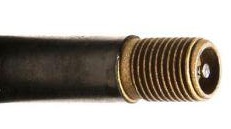

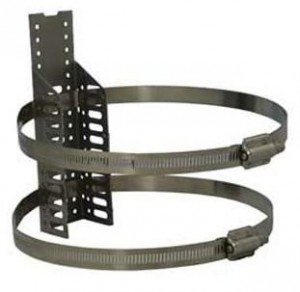



Excellent article! One of the first questions I had for DIY.StackExchange was related to a bad expansion tank, it is good that there is an official article that we can link to this on the Q&A site.
My only comment is that it is important to take the initial pressure reading of your system right after running the hot water for a several seconds just before. This releases any built up pressure from the water heater and gives you the most accurate reading.
You’re correct. You want to measure the incoming cold water supply pressure only, not the increased pressure caused by heating the water. I’ve removed the bit about turning the heater back on before measuring pressure, which should eliminate the possibility that the heater has affected the system pressure in any way.
The tank bracket image looks to be assembled backwards. The straps should be on the opposite side of the mounting bracket than they are shown. (if the bracket was attached to a stud, the straps as shown look like they would wrap about the stud, not the tank.)
Otherwise, a great article!
mmm..Nope. The bracket is displayed in image exactly as it should be installed.
Great article, very detailed instructions. I just have one question: isn’t 2.5 gallons of maximum accepted capacity a little on the low side for a standard expansion tank? I was pretty sure that most accepted at least twice as much.
I have low water flow and pressure due to old pipework, so I contacted a company who suggested I need a 450 pressurised tank with pump, but this was too tall for the loft, so they said I could have 2 x 150 ltr tanks and pump for same price? I aked them if this would be sufficient water as it is now only 300 litre? They said I could have just 1 x 150 and pump and see how I go??? The company are called Challis and I really liked the look of the stuff but now I have no faith in them. I then contacted another company and they said that I did not need a pressurised tank just a holding tank and pump. However they wanted £1650 which seems a awful lot for a more simple tank? Unfortunately a new supply is out of question. I just want to be ale to run both hot and cold water tap at the same time and get water from both. Any ideas?
My expansion tank sprung a leak and water was sqirting out of a small hole. I turned off the valve right behing it, unplugged the hot water heater, and turned off the fuze for hot water heater. Is it safe till I get a plumber here?
There is a fitting between my expansion tank and the boiler which has an air valve sticking out the top. If I press the valve pin water comes out. What is this device and what is it for? Should air or water be in it?
DrBob, the valve you have is a purge/bleed valve, to remove air from the water system. There should be only water coming out of the valve when working properly.
This is a really excellent article. I moved into a newish house and there is no air in the vessel. I will follow your service instructions, but do I need to open some taps to allow the air pump to force the water out of the tank ( presumably this water has to go somewhere)…. this is assuming the bladder is ok?
Hi. I got a puzzling problem. I have a sealed pressurized system with an oil-fired condensing boiler (Firebird). The filling loop is located on the immersion tank and there is a pressure gauge fitted there. There is an expansion tank in the garage beside the boiler and it also has a pressure gauge. I seem to lose pressure (from 1 bar to zero) in a matter of hours, according to the gauge at the immersion tank. My plumber is certain I have a bad leak and has tried that leak-weld stuff (four bottles of it!) but it seems to have made no difference. This afternoon, I refilled the system to 1 bar (at the tank) to check for leaks under floors (none found). The pressure had dropped to 0.5 bar in less than one hour. Then I went out to the boiler to check the pressure on the expansion tank and it was at over 2 bar! The floor round the boiler seemed damp too. I turned on the heating to get some hot water (which seems to have worked), and went out to check the pressure at the expansion tank again. It was unchanged – and there was very hot water coming out of the safety valve (I’m told that’s what it is) on the side of the boiler. I had a huge puddle under it on the garage floor. So I turned the heating off immediately, but the safety valve is still dripping several hours later, although now the water coming out is only lukewarm. Help! Any ideas? Is this a bad leak in my system (meaning digging down to pipes!)? a failed expansion tank? a blockage in the system?
What happens when this damn thing explodes?!
How does one check an in-service expansion tank’s pressure when there is no valve present to isolate and drain the expansion tank?
There is always at least a main supply valve and a tap. Turn off the water supply and open a tap to let the pressure go. Then check the expansion tank’s pressure.
Hi. We just had our holding tank replaced and there is still air in the pipes and a cloudiness to the water. Is there something else that would be creating this problem?
OK. So what if we didn’t disconnect the tank prior to adding the air to the appropriate pressure?! Do we need to do it again, properly? Help, please! 🙂
ka boom
Yes, your pressure will be wrong. Disconnect and repressurise.
My expansion tank is making a noise similar to water hammer. However, it only does it periodically. Should I be concerned?
My tank keeps going on even when there is no water being run. The pressure needle doesn’t go down, but the pump activates about every 5 minutes for a few seconds. It still works fine in term of water pressure – but my plumber doesn’t seem to be able to figure out what is wrong – or maybe just a bad compression tank? Maybe too much pressure? Wrong setting? Wanted to check and see if there is an easy fix before pulling it out and returning it. Any feedback appreciated.
Great information! I was looking for it whole day
author youre an idiot expansion tanks do not absorb excess pressure from city water for that to happen water would need to be able to be compressed not gonna happen cause physics.however in a closed hydronic heating system water can not leave the pipe to enter the tank or vice versa because that would imply a vacuum again physics. in fact a compression tank in a heating system is actually the “point of no pressure change” now when heated water can expand volumerically and the tank allows air to be compressed tp absorb this thermal water expansion which also keeps the pumps from cavatating and air from building up which destroys plumbing. in your separate potable water the pressure tank serves other purposes like storage to prevent pump cycling etc
Have some respect. Also using complete sentences and proper grammar would be helpful in understanding your post.
Hi! I wish you can help me with my problem. 2 years ago we changed heating pipes in our house and right now not all of them give warmth. We bought good pipes, it was obbo electrical-components.com/obo butthe problem is that it was nested at the wall and to look on it we should damage it. Can you tell me is any other ways to check it, the other assumption is that there is a cork inside pipes!What can I do with my problem! Help me, please….
We have a backflow preventer, thermal expansion tank and pressure reducing valve setup as part of our gas fired forced hot water heating system. The pressure reducing valve started leaking and a plumber came out and replaced it. Initially the leaking stopped but it started leaking again several hours after he left. He came back a second and third time replacing the expansion tank and backflow preventer only to have the problem resurface within a day.
He says it is due to the pressure building up which is either due to the hot water tank putting back pressure to the system or one of the components he replaced is defective.
I have used this plumber before and never had reason to question his work but I feel he is just guessing now and it is getting expensive. Any guidance is appreciated.
Good info! I have a Noritz N-0751M tankless gas water heater. When I turn the hot water faucet in the kitchen on and off I get loud banging in the pipes. I installed an arrestor in the kitchen, but the banging is still there. Someone suggested to install a thermal expansion tank. I have been searching the Web for installation instructions with tankless water heaters, but found nothing! On what side does the tank have to be installed: cold or hot side? Any help is appreciated.
Great post! Thanks for sharing the handling ways of pressure with expansion tanks.
I would like to make sure that I have a tank that is long lasting, I want to have a tank that can take a lot of pressure. I want to make sure that the tanks are well known as well.